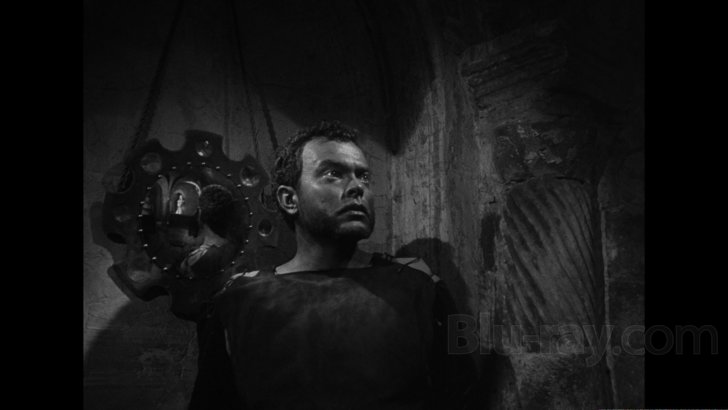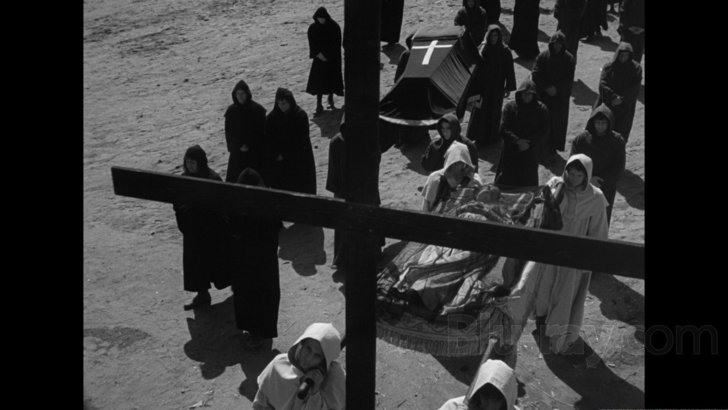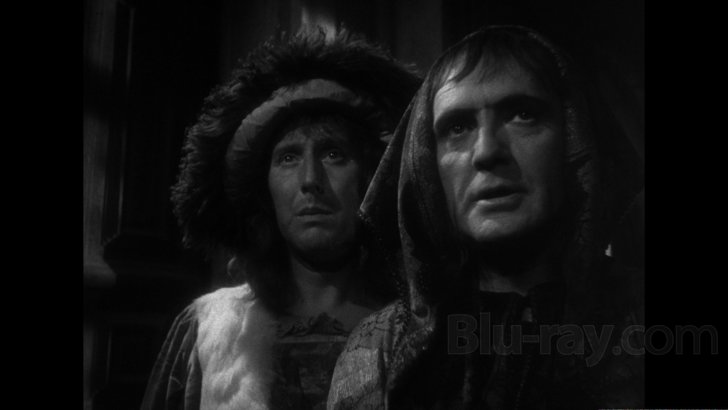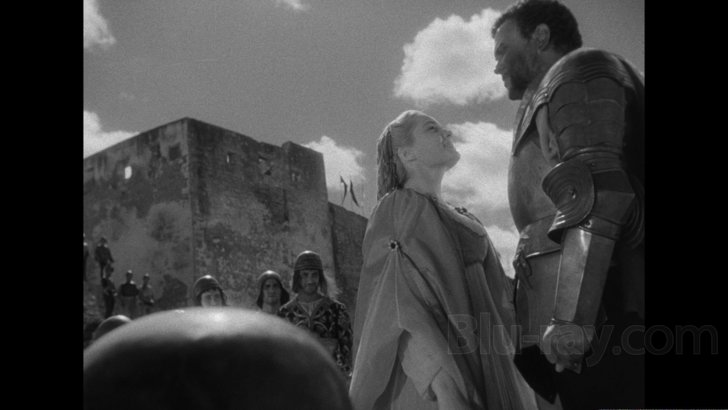Othello Blu-ray Movie
HomeOthello Blu-ray Movie 
The Tragedy of Othello: The Moor of VeniceCriterion | 1951 | 1 Movie, 2 Cuts | 93 min | Not rated | Oct 10, 2017
Movie rating
7.8 | / 10 |
Blu-ray rating
| Users | 0.0 | |
| Reviewer | 5.0 | |
| Overall | 5.0 |
Overview
Othello (1951)
The Moorish general Othello is manipulated into thinking that his new wife, Desdemona, has been carrying on an affair with his lieutenant, Michael Cassio, when in reality it is all part of the scheme of a bitter ensign named Iago.
Starring: Orson Welles, Micheál MacLiammóir, Robert Coote, Suzanne Cloutier, Hilton EdwardsDirector: Orson Welles
| Drama | 100% |
| Romance | 28% |
| History | 6% |
Specifications
Video
Video codec: MPEG-4 AVC
Video resolution: 1080p
Aspect ratio: 1.37:1
Original aspect ratio: 1.37:1
Audio
English: LPCM Mono (48kHz, 24-bit)
Subtitles
English SDH
Discs
Blu-ray Disc
Two-disc set (2 BDs)
Playback
Region A (locked)
Review
Rating summary
| Movie | 4.0 | |
| Video | 5.0 | |
| Audio | 4.5 | |
| Extras | 5.0 | |
| Overall | 5.0 |
Othello Blu-ray Movie Review
Reviewed by Dr. Svet Atanasov September 22, 2017Winner of Grand Prize at the Cannes Film Festival, Orson Welles' "Othello" (1952) arrives on Blu-ray courtesy of Criterion. The supplemental features on the two-disc set include an audio commentary by Peter Bogdanovich and Orson Welles' scholar Myron Meisel; new interview with scholar Francois Thomas; new interview with biographer Simon Callow; new interview with author Ayanna Thompson; and more. The release also arrives with an illustrated leaflet featuring an essay by film critic Geoffrey O'Brien and technical credits. In English, with optional English SDH subtitles for both versions of the film. Region-A "locked".

Othello
Orson Welles’ adaptation of William Shakespeare’s legendary Othello retains the core of the classic play, but it introduces the viewer to its characters and the reality in which they exist in a rather unusual fashion. Indeed, the film opens up with a funeral procession which reveals how it would end -- the bodies of Othello (Welles) and his bride (Suzanne Cloutier) are carried away, while the evil Iago (Micheal MacLiammoir) is placed in a giant cage. Welles then sends the viewer back in time and reassembles the events preceding the deaths of Othello and Desdemona.
The manner in which these events are presented is also unusual. The camera frequently follows Othello, but it is Iago that emerges as the more compelling character. The intensity of his manipulations and presence quickly overshadow Othello’s gradual descent into madness. As a result, there are large parts of the film where the dynamics of the relationships between Othello, Desdemona, and Iago certainly surprise.
The film’s visual design is arguably its biggest strength. (Opinions of course vary, but this reviewer certainly sides with those who believe that as far as Othello is concerned Welles is better as a director than he is as an actor). For example, the camera is not a casual observer but a curious entity which seems to exist amongst the main characters -- there are very unique angles/peeks, tracking shots, and different zooms that greatly enhance the film’s special atmosphere. The balance between light and shadow also supports the spirit of the play, but it gives the film a noir-esque edge the feels strikingly original.
Welles shot Othello over a long period of time and at different locations (Morocco and Italy). Because of budget limitations, different actors were also considered for different roles. For example, before choosing Cloutier for the role of Desdemona, Welles worked with Italian icon Lea Padovani and Betsy Blair. Unsurprisingly, at times the final version of the film could look somewhat uneven. It certainly could sound somewhat uneven as well -- parts of the dialogue could be too thin or muffled -- though one could probably easily argue that its production limitations are actually an integral part of the film’s charm.
The theatrical and home video markets have seen different versions of Othello. In an outstanding new featurette produced by Robert Fischer for Fiction Factory, American film historian and writer Joseph McBride (Orson Welles; What Ever Happened to Orson Welles?: A Portrait of an Independent Career) mentions four different versions of the film: an Italian dubbed version from 1951 with another director doing the dubbing and other actors doing the different parts; the official premiere version screened at the Cannes Film Festival in 1952 (which is typically considered to be the original version); the American version of the film which was reedited by Welles and released in 1955; and the restored version of the film from 1992, which features different soundtrack modifications and audio adjustments and was approved by Beatrice Welles-Smith, the American director’s third daughter.
*Unlike the French release that Carlotta Films produced in 2014, which features a 2K restoration of the 1992 version of Othello, Criterion's upcoming release features brand new 4K restorations of the 1952 and 1955 versions.
Othello Blu-ray Movie, Video Quality 

Presented in its original aspect ratio of 1.37:1, encoded with MPEG-4 AVC and granted a 1080p transfer, Orson Welles' Othello arrives on Blu-ray courtesy of Criterion.
The following text appears inside the leaflet provided with this Blu-ray release:
"This new digital transfer of the 1952 European version was created in 4K resolution on an ARRISCAN film scanner from a 35mm fine-grain master positive. This new digital transfer of the 1955 U.S. and UK version was created in 4K resolution on an ARRISCAN film scanner from the 35mm original camera negative. Thousands of instances of dirt, debris, scratches, splices, and warps were manually removed using MTI's DRS, while Digital Vision's Phoenix was used for jitter, flicker, small dirt, grain, and noise management. For both versions, the monaural soundtrack was remastered from composite fine-grain prints. Clicks, thumps, hiss, hum, and crackle were manually removed using Pro Tools HD and iZotope RX.
1952 Version
Scanning: Eclair/Groupe Ymagis, Epinay-sur-Seine, France.
Colorist: Russell Smith.
1955 Version
Scanning: Universal StudiosPost, Universal City, CA.
Colorist: Lee Kline."
Included on this release are two versions of Othello that have been recently restored. Please note that the screencaptures that are included with our review appear in the following order:
1. Screencaptures #1-20: Restored 1952 Version.
2. Screencaptures #22-35: Restored 1955 Version.
1952 Version: I did some direct comparisons with the French release that Carlotta Films produced a few years ago, which I liked quite a lot, and my impressions are that there are two substantial differences between the previous 2K restoration and the new 4K restoration. First, there are very noticeable improvements in terms of density and you do not have to have a projector to identify them. Plenty of close-ups make the difference very obvious (see screencaptures #2 and 4). There is plenty of panoramic footage where there are marginal improvements in terms of depth, though I should say that an overall improved shadow definition and image balance also contribute to it. On the other hand, the same minor density fluctuations that were present on the previous restoration remain. (We already clarified in the previous review that they are inherited from the existing elements). Second, the visuals are better balanced. The grayscale has better balanced blacks and whites with more convincing gray nuances. There are obvious differences during indoor and outdoor footage, but compare screencapture #10 and screencapture #6 to get a general idea what type of difference to expect. Furthermore, there appear to be some additional stabilization improvements that also strengthen the overall appearance of the film. Grain is finer and better resolved, as it should be after a 4K restoration. (Basically, you should see 'tighter' images while viewing the film). There are no problematic sharpening adjustments. Age-related imperfections have been removed as best as possible, though some minor dirt specks remain as they appear to have been printed a long time ago. All in all, even though some source limitations remain, the new 4K restoration is clearly superior and undoubtedly the most convincing presentation of the film.
1955 Version: There are some more pronounced density fluctuations on display, especially early into the film, and the overall image balance is definitely a notch and in some areas even two below that of the 1952 version. You can see the difference even if you directly compare the grayscale balance between different segments -- some appear healthier, and some basically lose definition (compare screencaptures #7 and 23). Elsewhere it is actually painfully obvious that time has left its mark and the quality of the available elements isn't optimal (see screencapture #30). However, this isn't how the entire film is, and there large areas where the quality is essentially on par with that of the new presentation of the 1952 version. To be perfectly clear, the starting point for the 1955 version was different and this is reflected in the end result. So the restoration is indeed very good, but you will see that time was clearly more unforgiving here. All in all, given the history of this film and its versions, I think that what is offered is about as definitive as anyone interested in the film would have hoped to get on Blu-ray. (Note: This is a Region-A "locked" Blu-ray release. Therefore, you must have a native Region-A or Region-Free Blu-ray player in order to access its content).
Othello Blu-ray Movie, Audio Quality 

Lossless English LPCM 1.0 tracks are provided for both versions of Othello. Also, each version can be viewed with optional English SDH subtitles.
There is additional work done on the lossless track for the 1952 version, but anyone expecting a drastic change in terms of overall balance and clarity will be disappointed. The reason for this is simple: the original soundtrack has plenty of native unevenness, thinness/softness, and even flat spots where the dialog/monologue can be rather difficult to hear and comprehend. I would say that the lossless track on this release is superior to the one that was included on the French release, but for ideal viewing experience you will almost certainly need to use the optional English subtitles.
The 1955 version comes with a different soundtrack that is easier to follow and has better balance. However, the production limitations are still very obvious, so in terms of dynamic intensity and fluidity the end result is far from impressive.
Othello Blu-ray Movie, Special Features and Extras 

DISC ONE
- Audio Commentary for the 1955 Version - this archival audio commentary features Peter Bogdanovich and Orson Welles' scholar Myron Meisel. It was recorded in 1994, and it initially appeared on Criterion's LD release of Othello.
1. "Like breathing pure oxygen"
2. Welles's Othello
3. The effect of entrances
4. Postsync sound
5. John Ford's influence
6. Welles's setups and blocking
7. Shooting without sound
8. The editing of Othello
9. The longest take in the film
10. "Iago the impotent"
11. "A post-Eichmann Iago"
12. Othello's imperfections
13. Orson's openness
14. A kind of silent film
15. Iago as director
16. Orson's costumes
17. Fay Compton
18. Allusions to sacraments
19. Pity of Othello
20. Othello vs. Kane
21. "Keep on shooting"
- Filming "Othello" - Orson Welles' final completed project, which is narrated by its creator, examines the genesis of Othello, its strengths and flaws, and its lasting appeal. The iconic director/actor also shares a number of interesting anecdotes, including one about an important figure at a very important film festival that could not figure out what the Moorish national anthem was. In English, not subtitled. (83 min, 1080p).
- Return to Glennascaul (1951) - presented here is Hilton Edwards' short film, which is also known as Orson Welles' Ghost Story. Orson Welles stars in it and narrates it. Actor Micheal MacLiammoir (Iago) was one of its producers. Also included with the film is an archival introduction by Peter Bogdanovich. In English, not subtitled. (28 min, 1080p).
- Souvenirs d'"Othello" - this Canadian documentary features archival conversations with actress Suzanne Cloutier (Desdemona) in which she shares her memories of working with Orson Welles during the production of Othello. The conversations were filmed in Venice in 1994, and in Essaouira in 1994. The documentary was produced for Canadian TV. In English and French, with optional English subtitles where necessary. (49 min, 1080i).
- Filming "Othello" - in this new video interview, explains what prompted Orson Welles to move to Europe in 1947 and discusses the difficult production history of Othello (with specific and very interesting comments about his casting choices and how they defined the tone and atmosphere of the film). The interview was conducted exclusively for Criterion in 2017.In English, not subtitled. (22 min).
- Joseph McBride - in this new featurette, film historian and author Joseph McBride (Orson Welles; What Ever Happened to Orson Welles?: A Portrait of an Independent Career) deconstructs Othello, highlights some of its unique qualities, some interesting differences between the main versions of the film, and discusses its difficult production history. There is a slightly longer version of the featurette on Carlotta Films' release of Othello. The featurette was produced by Robert Fischer for Fiction Factory. In English, not subtitled. (33 min, 1080p).
- Francois Thomas - in this brand new video program, Francois Thomas, coauthor of Orson Welles at Work, discusses the editing of the different versions of Othello. The programs was created exclusively for Criterion in 2017. (19 min, 1080p).
- Leaflet - an illustrated leaflet featuring an essay by film critic Geoffrey O'Brien and technical credits.
Othello Blu-ray Movie, Overall Score and Recommendation 

Considering the difficult and truly quite unusual production history of Orson Welles' Othello as well as how the different versions of the film have aged, it is pretty clear that the folks at Criterion did everything they could to offer the very best possible presentations of the 1952 and 1955 versions. Both have been restored in 4K and I like how they look a lot, though obviously because of source limitations the end results are different. The two-disc set also has an excellent selection of new and archival supplemental features, one of which is the old audio commentary with Peter Bogdanovich and Myron Meisel that many years ago appeared on Criterion's Laserdisc release of Othello. VERY HIGHLY RECOMMENDED.
Similar titles
Similar titles you might also like

The Magnificent Ambersons
1942

Chimes at Midnight
1965

Europe '51
Europa '51 / The Greatest Love
1952

Sunrise
Sunrise: A Song of Two Humans
1927

Make Way for Tomorrow
1937

Macbeth
Signature Edition
1948

Daisy Miller
Special Edition
1974

Romeo and Juliet
1954

Death in Venice
Morte a Venezia
1971

The Last Command
1928

The Fugitive Kind
1960

Senso
1954

Macbeth
The Tragedy of Macbeth
1971

Accident
1967

The Edge of the World
1937

The Night Porter
Il portiere di notte
1974

I Am Love
Io sono l'amore
2009

Journey to Italy
Viaggio in Italia / Voyage to Italy
1954

No Bears
خرس نیست / Khers nist
2022

Summertime
1955
